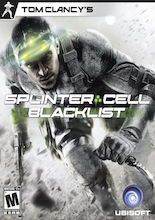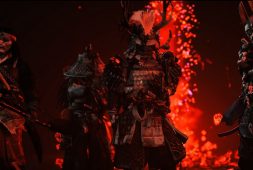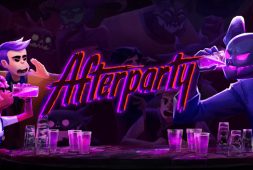Splinter Cell: Blacklist
Click Here to Learn More About our Reviews
Splinter Cell is a long-running Tom Clancy action series. Tom Clancy games are typically lauded for their real-world aspects and tactical gaming approach. They are games for people who can understand war-time scenarios and appreciate the nuances of political undercover work. Splinter Cell: Blacklist is the latest installment in the series. A fair amount of backstory is needed to fully understand the characters, but the main character is Sam Fisher.
This game is mostly a stealth-action game, with precision and timing being a key factor in how the game is played. However, unlike many mainstream games, Splinter Cell offers a variety of methods in which to reach your objective. You can sneak past all enemies without being detected, silently take out all forces, or use an array of gadgets to stun or incapacitate your foes. The variety of gameplay makes for an interesting combination of choices with which to deal with any situation.
WHAT PARENTS NEED TO KNOW
Violence:
The violence in this game is at the forefront of the storyline. The game starts off with an execution via bullet to the head. The violence in cut-scenes does not decrease from there and includes interrogations and explosions that kill or severely injure many. However, during gameplay, the player has the option to attack lethally or non-lethally. A player can potentially play through the whole game without killing anyone.
Language:
Multiple uses of the “F” word, “S” word, “B” word, damn, hell, and others are used fairly frequently.
Sexual Content:
Some sexual tension and dialogue occur between Sam Fisher and Grim, one of the female characters. There is no observable nudity.
Spirituality:
Use of the Lord’s name in vain. Otherwise, nothing outright. Patriotism is heavy, but it is vastly different than spirituality.
Misc.:
Parents: Players can stop at any checkpoint along their mission.
Reviewer Thoughts:
Splinter Cell: Blacklist is one of the first games that I have seen in a while that rewards the player for being stealthy. Many games only give you rewards if you follow the most violent path, but you get rewarded evenly for considering the path without any violence. If you’ve read any of my previous reviews, you’ve seen how I object to violence against innocents and humans, especially for young children. And while there is plenty of violence in the game, it is possible for none of it to be player inflicted. This would be a good game to introduce if you want to see how your child reacts to on-screen violence, but I would not suggest it for anyone under 15. The rating is M, so it is not intended for children under 17. However, there are much “worse” M-rated games out there.
***Another Review for Splinter Cell: Blacklist
Game Description:
Splinter Cell Blacklist is the latest entry in the Tom Clancy games, and the last one to be made while he was alive. Splinter Cell games focus around stealth, and the ability to think ahead and figure out what to do next. It is the opposite of modern first person shooters, which involve running and gunning.
Sam Fisher is a member of The Fourth Echelon, a small military group that seems to be able to do whatever it pleases, and has almost infinite resources, including a plane bigger than Air Force One. After an attack on a military base when Sam is staying, a terrorist network known as The Engineers, announces to the world that they will attack various ways of American Life (such as American Freedom, and American Consumption) and cause mass casualties, unless America sends its troops home. After Sam’s partner is wounded, he and the rest of his team must stop the Engineers, before the can kill more innocent civilians.
WHAT PARENTS NEED TO KNOW
Please note that everything illustrated in this section comes from the main campaign. No side missions, co-op missions, or multiplayer were played.
Violence:
Generic: Splinter Cell is a very violent game. It is packed full of explosions, gun fights, and other simulated violence. The player can use many small arms weapons, including Submachine Guns, Assault Rifles, Shotguns and Pistols. Being a stealth game, the player can also use a knife, or snap necks. A UAV is used to shoot cars, and launches missiles. The game does put a heavy focus on not killing, and it is possible to go through the entire game without the player killing anyone (aside from the UAV parts).
Terrorism: The story is about terrorism, so there are many attempted and successful terrorist attacks against the US. In the beginning, a military base is blown up, and many soldiers are killed. Most of them are unarmed, and are executed by the intruders. Later on, there is a Bioterrorism attack, an attack on American fuel, which creates a massive fire, and many high ranking officers and US officials are taken as hostages. The terrorists fight very dirty to make sure everything goes as they planned. Hostages are used by the terrorists on a regular basis, both as human shields, and as negotiation tools. First Responders to a fire and medical emergency are targeted, to make sure no one gets helped. The terrorists also use torture, but the protagonist of the story does as well.
Torture: Sam and the terrorists torture multiple people in the game. Sam and the antagonist even use the same line when torturing someone, just to show the players that there are similarities between the two men. The antagonist is videotaped torturing a hanging soldier, who pleads to stop because “he has a wife and a kid.” The young soldier gets his neck slit. Late in the game, the Secretary of Defense has his hand mutilated, by having multiple fingers cut off. While the actual act is not viewed, the player does get a glimpse of the severed stump later on. The Secretary is then threatened to have the rest of his fingers and toes cut off, and his teeth removed. Sam Fisher aggressively beats up multiple people in order to gain information, including using a folding chair to scissor a terrorist’s wrists whilst in Guantanamo. Electrocution is even used to get information.
Gore: During cutscenes, when someone is shot, blood sprays from the body. It’s not the little piff that is in Call of Duty games, but a short burst. During actual gameplay, it is much less noticeable, and can be avoided altogether if the player uses non-lethal tactics. Killed enemies will have blood pool on the ground, and fatally wounded and bleeding are encountered during missions and cutscenes.
Misc Violence: Wild and trained dogs can be shot, the player gets in a helicopter crash, a teammate is injured by grenade shrapnel, and Sam is poisoned. The Secretary of Defense is killed by the second playable character, so that he will not give up any more information.
Language:
The Profanity Tracker had quite a high count this game. F***, B****, and Sh** were used during the opening cutscene alone. The numbers given are the amount of times I encountered the various words. The amount may change depending on how much exploration the player does.
F***: 21. Sh**: 24. Lord’s name in vein: 5. Hell (used out of context): 7. B****: 3. Da**: 3. A**: 4. Pi**: 3. Bas****: 1. Cr**: 1 .
Sexual Content:
The hacker of the group mentions that there is “a lot of freaky porn” on a phone, and the female on the team has her shirt borderline too open.
Spiritual Content:
None
Miscellaneous:
Low Team Value: Neither Sam’s team, nor the terrorists really seem to care that much about their teammates. When the terrorists are shooting at the group of First Responders, one of the terrorists becomes trapped under burning wreckage, and is knocked unconscious. One of his teammates tries to rescue him, but is told to “leave him alone, and get back to work.” In the first mission of the game, a terrorist is wounded, and is given a grenade. He is told to “do as much damage as possible.” He ends up blowing himself up, and fatally wounds one of Sam’s teammates. When Sam is poisoned, his teammate helps him rather than go after the head terrorist, and for the next few missions, Sam keeps him from helping, and ignores him. Later, the situation happens in reverse, and the teammate is injured. Sam goes after the main bad guy rather than helping. Sam constantly ignores teammates’ advice and opinions, as well as those of the government. He believes that he always knows what the right thing to do is.
Drugs: The word “toke” is used once, an opium farm is infiltrated, and a teammate mentions “really integrating drug production.”
A Child’s Perspective:
I did not allow my 12 year old sister to watch me play, due to the strong language and violence, but the little parts she did see, she quickly grew bored of. The stealth aspect is geared towards older players, who can think ahead, and plot out what is going to happen. The story has a hard time hooking in older players, and children would not be able to follow along at all. The part they would enjoy the most would be the Spy vs. Merc(enary) multiplayer mode, which pits players against each other as spies try to stealthily try to hack computers, and use the shadows to take out the Mercs, while the Mercs use heavy weapons and explosive equipment to stop the Spies.
I should note that the game actually says that young kids shouldn’t play the game. Two terrorists, who are guarding hostages, can be overheard saying:
Terrorists A: “This (referring to the situation they are in) is just like the game my kid plays.” Terrorist B: “Why would you let your kid play a game like this? It would be full of violence, hostages, and language.” In that conversation alone, Ubisoft makes it clear that this Splinter Cell is for the older players.
Reviewer’s Thoughts:
In between long loading times, Splinter Cell Blacklist came off as a Tom Cruise movie: the main character is unstoppable no matter what the circumstance is, and the situations keep getting more and more dangerous. Unlike Tom Cruise movies, there is actually very little character development. The characters don’t grow at all, and they don’t seem to learn anything. Sure they mess up, but they keep on going like it didn’t happen. The story is pretty generic: bad guys are attacking the US, and they are using terrorism to send a point. I only liked two of the characters, and that was a black market dealer, and the team’s tech expert, Charlie. Without them, the game would have been significantly more boring. The villain was more interesting than Sam Fisher, because he had more than “agitated, frustrated, and indifferent” as emotions.
Mechanically, and gameplay-wise Ubisoft does quite a few cool things with the game. They reward how the player plays. If he goes Rambo, and shoots his way through things, he gets very few points. If the player uses stealth lethally, he is rewarded some points. If the player uses stealth, and kills no one, but uses non-lethal methods, he is rewarded with the most points. I was very impressed with the emphasis the game put on not killing people and using stealth. The fact that the player can switch between lethal and non-lethal knockout hand-to-hand techniques is cool, and players are issued a non-lethal weapon, such as a stun gun and a knockout gas crossbow. Players receive bonus points for avoiding enemies altogether, and the best achievement of the game states that the player cannot kill anyone during the entire campaign. During various points of the game, there will be a few people that the games thinks the player would really want to kill. These people are some of the top terrorists, and are the reason the attacks were successful. When Sam meets up with these people, the player gets to choose if they want to kill or spare that person. I never felt emotionally tied to the game enough to want to kill them, and I always knocked them out instead. What did bother me was that (without spoiling anything) the kill vs. spare option was taken away with the final boss.
Despite the problems I had with Blacklist, I had a lot of fun with it. The last Splinter Cell had me going from pipe to pipe, dropping down on enemies from above. Now, I got to control a mini helicopter, which could shoot tasers. I could customize and upgrade Sam how I wanted to play: I could either pack heavy, and used Kevlar armor and an Assault Rifle, or I could don my spy suit, and quietly slip past people with noisemakers and sticky cameras. The multiplayers is a blast as well, and during the one game I got to play, I enjoyed the various play styles that came with the spies and the mercenaries.
I would equate Blacklist to a rated R movie. A 15 or 16 year old would probably be fine playing it, but I would be hesitant to let anyone younger get ahold of it, due to the frequent uses of strong language, and graphic violence. Unlike Call of Duty or Halo, this Blacklist truly deserves its M rating, and has way more violence and language than either of those series.
Jonathan McKee
Jonathan McKee is the author of over twenty books including the brand new The Guy's Guide to FOUR BATTLES Every Young Man Must Face; The Teen’s Guide to Social Media & Mobile Devices; If I Had a Parenting Do Over; and the Amazon Best Seller - The Guy's Guide to God, Girls and the Phone in Your Pocket. He speaks to parents and leaders worldwide, all while providing free resources for parents on his website TheSource4Parents.com. Jonathan, his wife Lori, and their three kids live in California.




